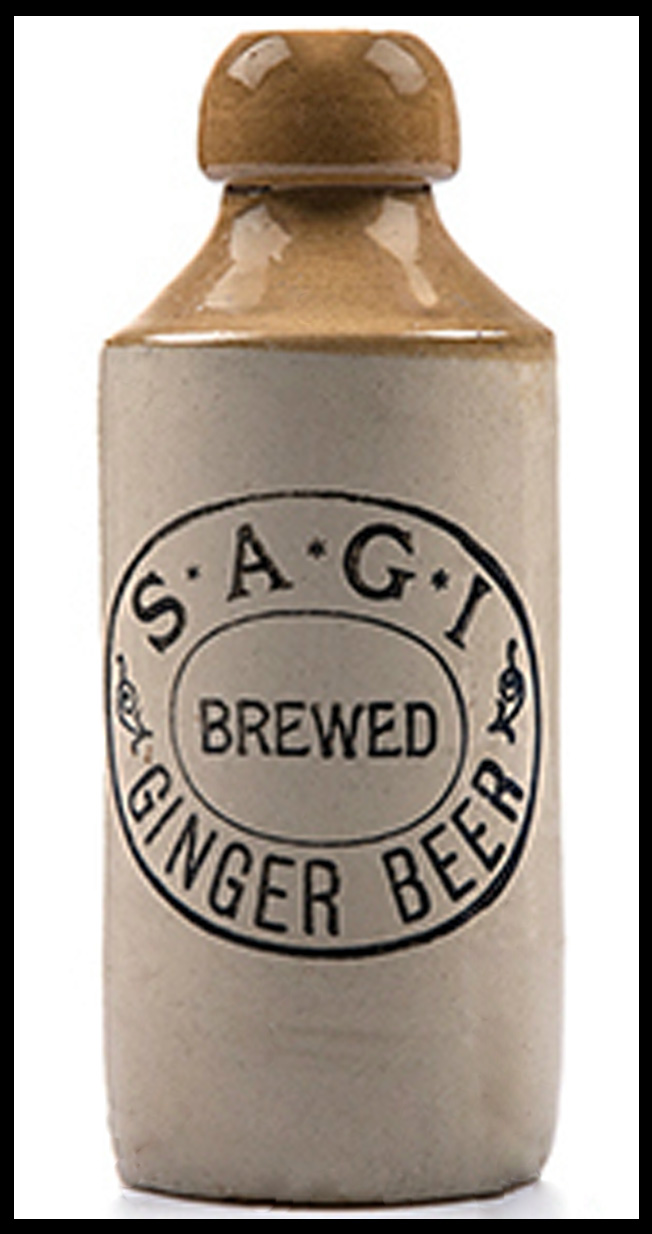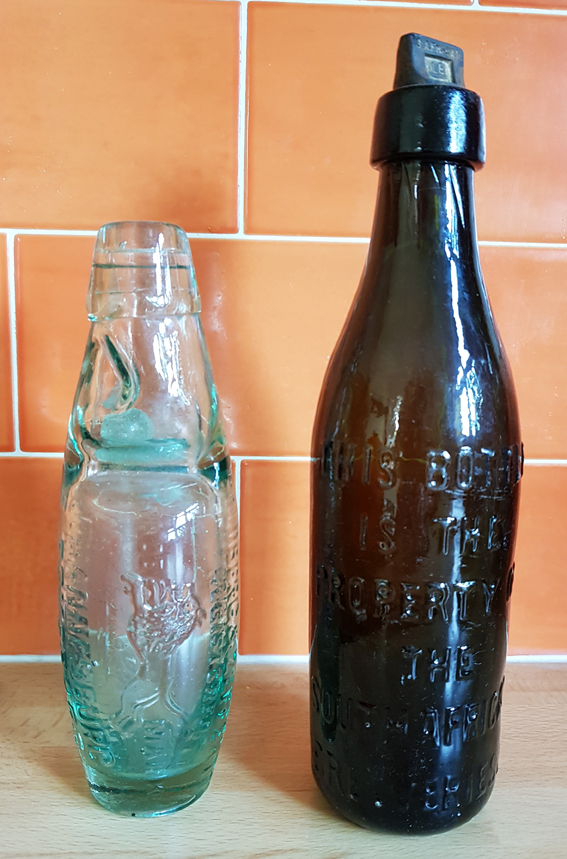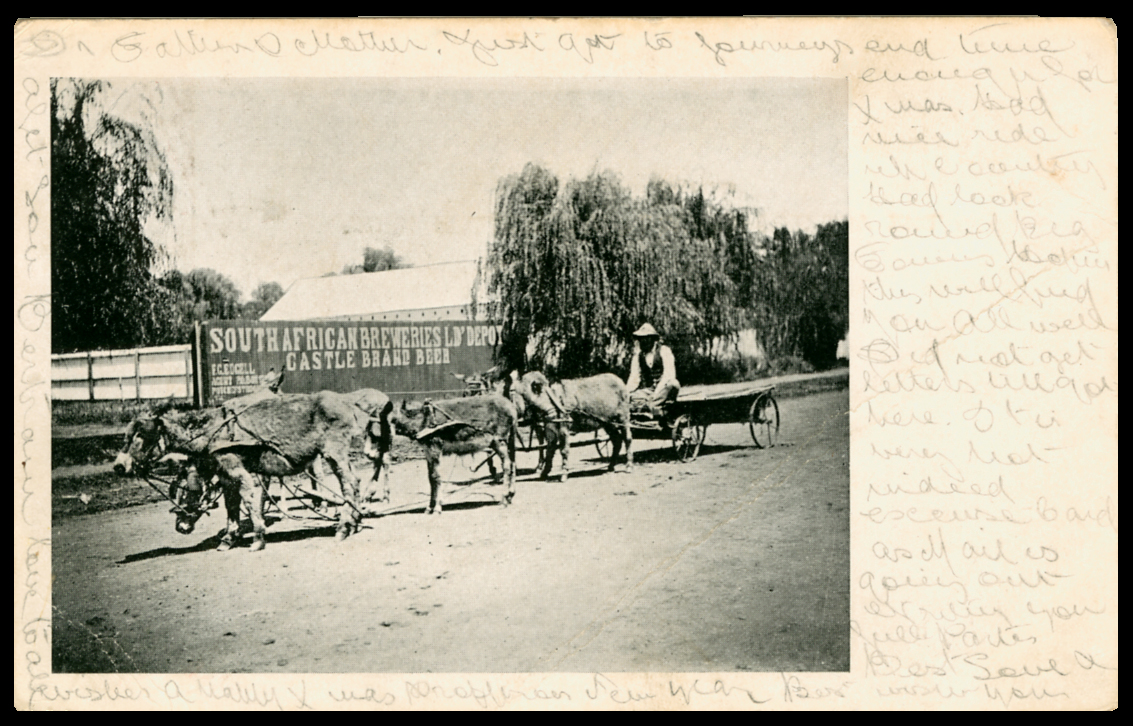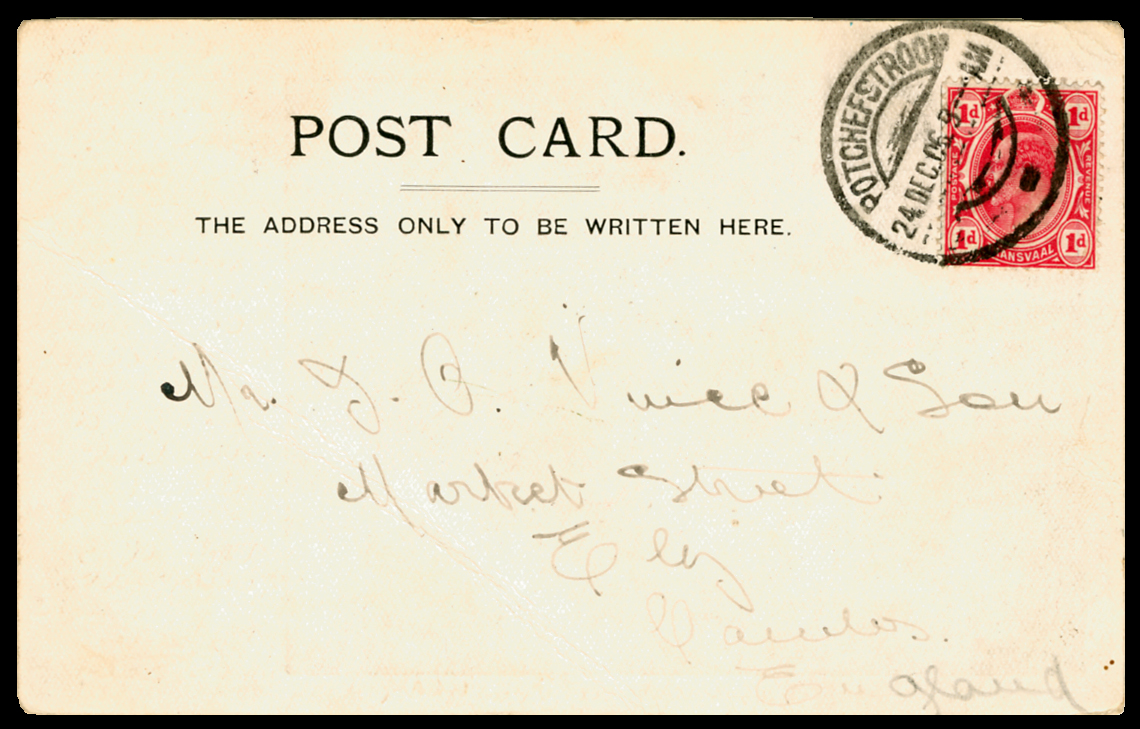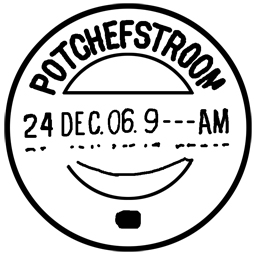Potchefstroom 1906 - The Moon's a Banana
Quote from Steve on October 17, 2022, 12:00 pmMy apologies to David Niven's 'The Moon's a Balloon'.
I have lived in Cambridge, England, since 2000 after moving here from London in order to claim some association for my business with Britain's centre of excellence in science and technology. In doing so I had to forfeit my one true London joy - regular attendance in the very early hours of every Saturday morning at the Charing Cross Stamp Fair in the underground car park beneath Embankment Tube Station, London. It's still there in 2022. Go visit it!
I bought the postcard below at one of the first monthly Stamp Fairs that I attended in Arbury, Cambridge in 2001. I bought it for no reason other than that it showed an SAB (South African Breweries) depot, possibly in Potchefstroom. I had spent a happy time digging up colonial rubbish dumps around Cape Town with the legendary Jimmy Macdonald, Andrew Halkett and David Hamilton. (Curiously my best SA friends were all of Scots descent. This must include Byron Reid.) In plundering the Belleville 'tip' like a tomb-raider of yore I became familiar with SAB and Ohlsson Breweries beeer bottles of the type that would have been held in the postcard's depot. In fact, I have one with me still. See below.
About 20 years later I decided to put together a display on the 'Postmarks of the Cantonments of the British Army of Occupation in South Africa - 1902 -1919'. However, as this title limited my display to Cantonments only I changed it to 'Postmarks from the Imperial Garrison - The British Army of Occupation in South Africa - 1902 -1919. This opened my display up to include British Army camps in SA that were not true Cantonments, places like Fort Napier and Ladysmith in Natal and the Castle and Wynberg in the Cape, etc. (A Cantonment is a garrison or camp which holds both a military and a civilian population.) As some camps did not have a Cantonment post office using a Cantonment postmark they had an arrangement with the local town's civilian post office to process their mail. When I realised that a lot of mail from the Imperial Garrison was stamped with everyday datestamps from the local town post office I was able to considerably expand the range of postmarks used by the garrison in my display.
As a result, when I found my SAB postcard bearing a Potchefstroom postmark I looked at it with fresh eyes. It was addressed to Ely, (a Fenland isle named after the once plentiful eels that inhabited the surrounding wetland). As Ely is 25 minutes down the A10 from where I live I wondered who the addressee in Ely, J. O. Vince & Son, was and also who had sent it to them from Potchefstroom in 1906, the heyday of the 'Potch' Cantonment. Was it a soldier? Surprise, surprise. This postcard was sent to an Ely coachbuilder, John Orviss Vince (1846–1923), by 'Bert', presumably his son Albert Edward Vince (1885–1954). Vince & Son constructed a variety of horse-drawn vehicles. With the British Army in South Africa relying on wagon transport it had a need for men with wagon-building and repairing skills. It is possible that Albert was serving a short service Army contract. Perhaps he chose to send this card to his father because it showed a common South African mode of transport, the rickety old donkey cart? Albert would take over Vince & Son during the inter-war period when the business grew to include early motor-buses, like ‘Vince’s Golden Queen’.
The postmark on the postcard is Putzel's No. 15. His example is also from 1906, suggesting this datestamp may have been in short-lived use roundabout this time. The postmark is unusual for having two distinctive bits of damage - a broken 'M' in Potchefstroom (also seen in other Divided Double Circle datestamps) and a much more unusual collapsed horizontal line in its crescent moon. This has deflated the moon and given it the appearance of a banana. The deltiological and postal history lesson from all of this is always pursue subjects you enjoy. Never take anything for granted. Always look and learn. You may be pleasantly surprised what you discover so close to home.
The images below are:
1]. SAGI (SA Garrison Institute - a forerunner of the NAAFI) Ginger Beer Bottle. The original 'cool drink!', Jamie!.
2]. A Marble Bottle (left) from Goldberg & Zeffe of Johannesburg and Boksburg and an SAB Beer Bottle (right).
3]. Albert's postcard to his father showing the South African Donkey Cart.
4]. The postcard's front addressed to J. O. Vince & Sons, Ely, Cambs, England. From 'Bert' in Potchefstroom.
5]. A reproduced postmark showing the Broken 'M' and the Half Moon as a banana. (Afr. piesang, from Malay.)
My apologies to David Niven's 'The Moon's a Balloon'.
I have lived in Cambridge, England, since 2000 after moving here from London in order to claim some association for my business with Britain's centre of excellence in science and technology. In doing so I had to forfeit my one true London joy - regular attendance in the very early hours of every Saturday morning at the Charing Cross Stamp Fair in the underground car park beneath Embankment Tube Station, London. It's still there in 2022. Go visit it!
I bought the postcard below at one of the first monthly Stamp Fairs that I attended in Arbury, Cambridge in 2001. I bought it for no reason other than that it showed an SAB (South African Breweries) depot, possibly in Potchefstroom. I had spent a happy time digging up colonial rubbish dumps around Cape Town with the legendary Jimmy Macdonald, Andrew Halkett and David Hamilton. (Curiously my best SA friends were all of Scots descent. This must include Byron Reid.) In plundering the Belleville 'tip' like a tomb-raider of yore I became familiar with SAB and Ohlsson Breweries beeer bottles of the type that would have been held in the postcard's depot. In fact, I have one with me still. See below.
About 20 years later I decided to put together a display on the 'Postmarks of the Cantonments of the British Army of Occupation in South Africa - 1902 -1919'. However, as this title limited my display to Cantonments only I changed it to 'Postmarks from the Imperial Garrison - The British Army of Occupation in South Africa - 1902 -1919. This opened my display up to include British Army camps in SA that were not true Cantonments, places like Fort Napier and Ladysmith in Natal and the Castle and Wynberg in the Cape, etc. (A Cantonment is a garrison or camp which holds both a military and a civilian population.) As some camps did not have a Cantonment post office using a Cantonment postmark they had an arrangement with the local town's civilian post office to process their mail. When I realised that a lot of mail from the Imperial Garrison was stamped with everyday datestamps from the local town post office I was able to considerably expand the range of postmarks used by the garrison in my display.
As a result, when I found my SAB postcard bearing a Potchefstroom postmark I looked at it with fresh eyes. It was addressed to Ely, (a Fenland isle named after the once plentiful eels that inhabited the surrounding wetland). As Ely is 25 minutes down the A10 from where I live I wondered who the addressee in Ely, J. O. Vince & Son, was and also who had sent it to them from Potchefstroom in 1906, the heyday of the 'Potch' Cantonment. Was it a soldier? Surprise, surprise. This postcard was sent to an Ely coachbuilder, John Orviss Vince (1846–1923), by 'Bert', presumably his son Albert Edward Vince (1885–1954). Vince & Son constructed a variety of horse-drawn vehicles. With the British Army in South Africa relying on wagon transport it had a need for men with wagon-building and repairing skills. It is possible that Albert was serving a short service Army contract. Perhaps he chose to send this card to his father because it showed a common South African mode of transport, the rickety old donkey cart? Albert would take over Vince & Son during the inter-war period when the business grew to include early motor-buses, like ‘Vince’s Golden Queen’.
The postmark on the postcard is Putzel's No. 15. His example is also from 1906, suggesting this datestamp may have been in short-lived use roundabout this time. The postmark is unusual for having two distinctive bits of damage - a broken 'M' in Potchefstroom (also seen in other Divided Double Circle datestamps) and a much more unusual collapsed horizontal line in its crescent moon. This has deflated the moon and given it the appearance of a banana. The deltiological and postal history lesson from all of this is always pursue subjects you enjoy. Never take anything for granted. Always look and learn. You may be pleasantly surprised what you discover so close to home.
The images below are:
1]. SAGI (SA Garrison Institute - a forerunner of the NAAFI) Ginger Beer Bottle. The original 'cool drink!', Jamie!.
2]. A Marble Bottle (left) from Goldberg & Zeffe of Johannesburg and Boksburg and an SAB Beer Bottle (right).
3]. Albert's postcard to his father showing the South African Donkey Cart.
4]. The postcard's front addressed to J. O. Vince & Sons, Ely, Cambs, England. From 'Bert' in Potchefstroom.
5]. A reproduced postmark showing the Broken 'M' and the Half Moon as a banana. (Afr. piesang, from Malay.)
Quote from Bas PAYNE on October 17, 2022, 12:33 pmHere's an example of Put 15 from May 1901 - the lower half-moon was undamaged then; yours is the latest example I've seen so far.
Here's an example of Put 15 from May 1901 - the lower half-moon was undamaged then; yours is the latest example I've seen so far.
Uploaded files:
Quote from Steve on October 17, 2022, 6:20 pmMany thanks for your feedback, Bas. Nice cover. Very lekker!
Your post raises a point about how we list postmarks. Ralph Putzelhad to work with what he had and try to get them into a some order starting with the oldest. However, as Alex Visser and you & others have now added almost the same number of postmarks again to Alex's Addendum, what Ralph offers is incomplete and sometimes wrong.
As you suggest, these two postmarks, yours and mine, are the same. You have the older example before it got damaged. These two postmarks illustrate the point I want to make. Ralph only had an example like mine from 1906 to list. He did not have yours from 1901. If he had had both he would no doubt have put them in order starting with the oldest, yours, as his No. 15 and mine as 15a.
The 'problem' is that we now have my postmark in Ralph's book as No. 15 and yours in Alex's Addendum as No. 15*. The example that Alex shows as No. 15* is from two days before yours, 21 May 01. He says "There are four dots at base, as shown by an early impression. In later copies, as shown in book, the dots are smudged or worn, giving the impression of a cross. The lettering is then also worn". This raises another issue - the value of drawn images. In my reproduction I made the four dots into a block because that is what I saw. Not a cross or four dots! And I saw a banana moon which Alex ignores, as does Putzel in his description. This latter is a very significant piece of damage to the datestamp, one that sets its apart as an oddity, maybe a rarity, certainly a curiousity .
Putzel lists many postmarks that have minor variations as subsets ie. 10, 10a, 10b, etc. Both of our datestamps certainly warrant their own listing. There are enough differences between these two postmarks to list them as a subset - but in what order? Because your's or Alex's example are earlier they should come first as No. 15 and my 'banana moon' should be 15a. But the die is cast. Putzel has set mine in stone as No. 15 and Alex and yours as no. 15*. This is wrong and ultimately should be corrected. These postmarks are now listed out of sequence. How do we correct this? Do we even want to? It is a huge amount of work that could only be done if many worked together.
It would be nice to re-organise these postmarks in sequence but it would take a younger, braver man than me to attempt it. I am not happy with this situation - it is not ideal - but it is something to consider doing. Such a project reminds me of the old joke about "How do you eat an elephant?". Answer. "One piece at a time!" Starting with 'A', I soon hope to add a new and unrecorded datestamp.
BTW, I have unilaterally decided to spell 'date stamp' as one word. 'Datestamp' is now the first entry in the Style Sheet of the South African Philately Club.
Many thanks for your feedback, Bas. Nice cover. Very lekker!
Your post raises a point about how we list postmarks. Ralph Putzelhad to work with what he had and try to get them into a some order starting with the oldest. However, as Alex Visser and you & others have now added almost the same number of postmarks again to Alex's Addendum, what Ralph offers is incomplete and sometimes wrong.
As you suggest, these two postmarks, yours and mine, are the same. You have the older example before it got damaged. These two postmarks illustrate the point I want to make. Ralph only had an example like mine from 1906 to list. He did not have yours from 1901. If he had had both he would no doubt have put them in order starting with the oldest, yours, as his No. 15 and mine as 15a.
The 'problem' is that we now have my postmark in Ralph's book as No. 15 and yours in Alex's Addendum as No. 15*. The example that Alex shows as No. 15* is from two days before yours, 21 May 01. He says "There are four dots at base, as shown by an early impression. In later copies, as shown in book, the dots are smudged or worn, giving the impression of a cross. The lettering is then also worn". This raises another issue - the value of drawn images. In my reproduction I made the four dots into a block because that is what I saw. Not a cross or four dots! And I saw a banana moon which Alex ignores, as does Putzel in his description. This latter is a very significant piece of damage to the datestamp, one that sets its apart as an oddity, maybe a rarity, certainly a curiousity .
Putzel lists many postmarks that have minor variations as subsets ie. 10, 10a, 10b, etc. Both of our datestamps certainly warrant their own listing. There are enough differences between these two postmarks to list them as a subset - but in what order? Because your's or Alex's example are earlier they should come first as No. 15 and my 'banana moon' should be 15a. But the die is cast. Putzel has set mine in stone as No. 15 and Alex and yours as no. 15*. This is wrong and ultimately should be corrected. These postmarks are now listed out of sequence. How do we correct this? Do we even want to? It is a huge amount of work that could only be done if many worked together.
It would be nice to re-organise these postmarks in sequence but it would take a younger, braver man than me to attempt it. I am not happy with this situation - it is not ideal - but it is something to consider doing. Such a project reminds me of the old joke about "How do you eat an elephant?". Answer. "One piece at a time!" Starting with 'A', I soon hope to add a new and unrecorded datestamp.
BTW, I have unilaterally decided to spell 'date stamp' as one word. 'Datestamp' is now the first entry in the Style Sheet of the South African Philately Club.
Quote from Bas PAYNE on October 18, 2022, 11:53 amSteve, Many thanks for raising this.
Numbering date-stamps in a catalogue is trickier than it sounds. In an ideal world, in which we know all the date-stamps used at an office and their first dates of use, we'd list and number them in order of the first date of use; but we don't have that knowledge.
Ralph Putzel did the best he could with the information he had, and listed date-stamps in what he thought was the right order; but we keep on finding new date-stamps and new earlier dates (earliest known dates - or EKDs). One option would be to renumber every time we find out something new - but that would create endless confusion as the numbers keep on changing. Another would be to give new date-stamps new numbers at the end of the existing list; but that would mean that a new nineteenth-century date-stamp would end up among the twenty-first-century date-stamps, which it would make it very time-consuming to find.
The solution Alex adopted when he was starting to produce his Addenda was to insert a new date-stamp at what seemed to be a reasonable place chronologically, with a number with an added letter at the end of the alphabet: thus a new date-stamp which probably came into use at about the same time as Put 16, gets the number Add 16x, or Add 16y if there is already an Add 16x and so on; (variants of the same date-stamp get added letters at the beginning of the alphabet, e.g. Add 16a,b and so on).
When Alex and I started in on the ZAR and Transvaal catalogue, we could have started with a clean slate, renumbering all the date-stamps we knew about in what looked like a better order; but we were very aware that creating a new set of numbers would cause a lot of confusion, and the new numbers would start to suffer from the same problems as the Put numbers as we found more new date-stamps and dates. So we decided to stay with the Put and Add numbers, adding to them in the same way as before; but listing the date-stamps in EKD order. Like democracy, it's an imperfect solution, but probably better than the alternatives .....
By the way a number with a star in Addenda (e.g. Add 15*) isn't a new or different date-stamp: it's Alex's way of flagging up that he's providing new information, a correction, or a new image, for a date-stamp described by Putzel.
Steve, Many thanks for raising this.
Numbering date-stamps in a catalogue is trickier than it sounds. In an ideal world, in which we know all the date-stamps used at an office and their first dates of use, we'd list and number them in order of the first date of use; but we don't have that knowledge.
Ralph Putzel did the best he could with the information he had, and listed date-stamps in what he thought was the right order; but we keep on finding new date-stamps and new earlier dates (earliest known dates - or EKDs). One option would be to renumber every time we find out something new - but that would create endless confusion as the numbers keep on changing. Another would be to give new date-stamps new numbers at the end of the existing list; but that would mean that a new nineteenth-century date-stamp would end up among the twenty-first-century date-stamps, which it would make it very time-consuming to find.
The solution Alex adopted when he was starting to produce his Addenda was to insert a new date-stamp at what seemed to be a reasonable place chronologically, with a number with an added letter at the end of the alphabet: thus a new date-stamp which probably came into use at about the same time as Put 16, gets the number Add 16x, or Add 16y if there is already an Add 16x and so on; (variants of the same date-stamp get added letters at the beginning of the alphabet, e.g. Add 16a,b and so on).
When Alex and I started in on the ZAR and Transvaal catalogue, we could have started with a clean slate, renumbering all the date-stamps we knew about in what looked like a better order; but we were very aware that creating a new set of numbers would cause a lot of confusion, and the new numbers would start to suffer from the same problems as the Put numbers as we found more new date-stamps and dates. So we decided to stay with the Put and Add numbers, adding to them in the same way as before; but listing the date-stamps in EKD order. Like democracy, it's an imperfect solution, but probably better than the alternatives .....
By the way a number with a star in Addenda (e.g. Add 15*) isn't a new or different date-stamp: it's Alex's way of flagging up that he's providing new information, a correction, or a new image, for a date-stamp described by Putzel.
Quote from Steve on October 18, 2022, 4:26 pmBas, many thanks for taking the time to reply to my long-winded post. As you say, "we could have started with a clean slate, renumbering all the date-stamps we knew about in what looked like a better order". The advantage of that, as opposed to any possible confusion created by a new numbering system, is that postal historians would have had a revised edition to reference rather than consult two complimentary but incomplete sets of data, one in ten printed volumes and the other on-line. I understand why you decided to stay with the Put and Add numbers but surely, if postal history has a long-term future, we will at some point need to produce a new and revised single edition.
Bas, many thanks for taking the time to reply to my long-winded post. As you say, "we could have started with a clean slate, renumbering all the date-stamps we knew about in what looked like a better order". The advantage of that, as opposed to any possible confusion created by a new numbering system, is that postal historians would have had a revised edition to reference rather than consult two complimentary but incomplete sets of data, one in ten printed volumes and the other on-line. I understand why you decided to stay with the Put and Add numbers but surely, if postal history has a long-term future, we will at some point need to produce a new and revised single edition.

